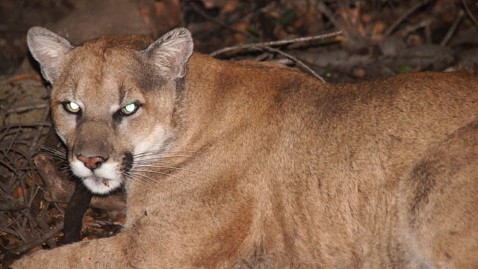Mountain Lion Calls Los Angeles' Griffith Park Home

Los Angeles's Griffith Park, a popular destination for hiking and cycling enthusiasts, is known for its abundance of wildlife. But a new creature, a 110 lb mountain lion, is calling the park home.
"P-22? is the first confirmed mountain lion sighting in Griffith Park, and the 22 nd lion the National Park Service has collared there. First spotted in March, P-22 was captured and collared soon after. But the GPS stopped working, and scientists have not been able to capture him again, though they know he's still in the park.
Scientists say that P-22 is from the Santa Monica Mountains, approximately 40 miles away.
Justin Brown, a biological technician for the park service, said they are unsure how the 3-year-old got to Griffith Park.
"He had to cross the 405 and the 101 freeways," said Brown. "We know where he didn't go. We know that he didn't cross bridges or go on any overpasses."
Some mused that Apple had a hand in the mountain lion's presence, reported the Los Angeles Times. "Mountain Lion" is the latest version of the MAC OSX.
Brown said that the lion settled in Griffith Park because of the high abundance of prey animals in the park.
"Griffith Park has a lot of deer and a high amount of prey animals. Once we captured him, we could tell that he had been eating well. I don't want to say he was fat, but he was definitely very healthy," Brown said, laughing.
Brown said P-22 was first seen on a U.S. Geological Survey camera that was set up for a general wildlife survey.
"The USGS saw him first and they told us about him," said Brown. "We then set up some traps and cameras throughout the park which send us a signal whenever there is movement."
Nine days after the cameras and traps were set up, Brown said he received a signal on his phone at 2 a.m. and saw that the lion was in one of their traps.
"As soon as we got the signal, we got the team together and went up to get him," said Brown. "We sedated him with a dart, and that put him to sleep. We then took the trap off and ran some tests."
Brown said that they took blood and DNA samples of the lion, which is how they were able to determine his origin.
After taking the samples, Brown said they fitted the lion with a GPS collar so they could track his movements.
"The GPS part is not functioning anymore," said Brown. "We are able to track it using radio waves and antennas, but we can no longer use the satellite to track him."
So far, scientists say the radio tracking method has been unsuccessful because the lion is so elusive. Because of this, scientists haven't been able to put a new collar on P-22.
Although the mountain lion is roaming in a highly populated and visited area, Brown said that people have nothing to worry about.
"We've had lions in the Santa Monica Mountains for decades and never had an incident. The odds of it happening are very rare," said Brown. "People don't need to worry."
And, added Brown, "We don't think he will be around there for long. Eventually he will want to go look for a mate and will run off."